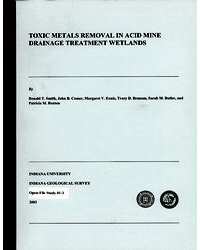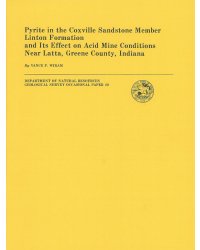ABSTRACT: The removal of trace metals from acid mine drainage was studied in four constructed wetlands on abandoned mine lands in southwestern Indiana. The wetlands vary in the constraints of their settings, their design, the materials used in their construction, and their effectiveness at removing metals. Aqueous and sediment samples were collected twice a year at each of sixteen sampling locations.Water, pore water, and sediment extracts were analyzed for their physicochemical characteristics, major ions, and the trace metals arsenic, beryllium, boron, cadmium, chromium, copper, lead, molybdenum, nickel, selenium, and vanadium. A simplified sequential extraction was used to distinguish between bio-available and residual metals. The relative distributions of metals between the bio-available and residual fractions were compared with one another in order to determine the factors which control precipitation, sorption, and mineralization of trace metals, and assess their potential mobility. Data representing late winter and late summer conditions were compared to identify seasonal differences in metals concentrations in the various wetland cells. The overall percentage of major metals removed from the AMD was determined. The Aquachem computer program was used to generate a diagram of the prevalent chemical character of the wetland waters and to introduce data to a water chemistry modeling program, PhreeqC. The PhreeqC program determined saturation indices for mineral phases in water entering and leaving the wetlands. The water and sediment metals values were compared with published criteria for water and sediment quality.
Smith, R. T., Comer, J. B., Ennis, M. V., Branam, T. D., Butler, S. M., Renton, P. M. 2003, Toxic metals removal in acid mine drainage treatment wetlands: Indiana Geological Survey Open-File Study 01-03, 48 p., 8 fig.
Notes: Publications in the Indiana Geological Survey Open-File series have been inconsistently named using a variety of series titles including "Open-File Report," "Open-File Map," and "Open-File Study." Prior to 1994, a publication in this series was generally referred to as an "Open-File Report" (but not always). To help reduce confusion created by these inconsistencies, the IGS now refers to every publication in the Open-File series as an "Open-File Study." To be entirely correct in writing a bibliographic reference for a publication, one should use the series name and number that appears on the publication itself.
You may also like:
Keywords: mine reclamation, acid mine drainage, geochemistry, mine, wetland
Can't find what you're looking for? Feel free to contact us directly:
Indiana Geological and Water Survey
1001 E. 10th St.
Bloomington, IN 47405
812-855-7636 (phone)
812-855-2862 (fax)
IGWSinfo@indiana.edu
IGS Return Policy
- Original sales receipt required.
- Returns accepted within 30 days of purchase date.
- Refund will be issued by the same method of payment as purchased.
- Products must be returned in the same new condition as purchased.
- Refunds on custom orders and digital products are NOT allowed.
- Customers are responsible for paying shipping costs to return products.
Updated 8/19/2020





